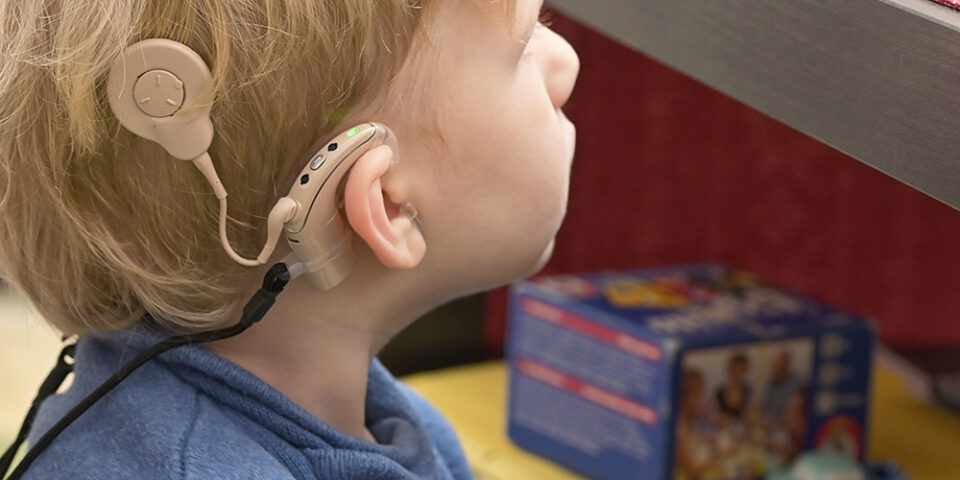How do cochlear implants work?
If you’ve ever seen those heartwarming videos online titled something like, “Deaf child hears her mother’s voice for the first time,” often what you witness is the aftermath of cochlear implant surgery or the installation of hearing aids in hearing-impaired or deaf individuals. While cochlear implants are just one option for those who struggle with hearing loss, they are getting increasingly well known. So, what are they? How do cochlear implants work? Are they the right choice for you or your child?
Brent J. Wilkerson, MD, offered answers to the most common questions about cochlear implants for children and adults.
What is a cochlear implant?
“Cochlear implants are designed to help patients who have moderate to severe or profound hearing loss,” said Dr. Wilkerson. “If conventional hearing aids can’t provide enough help, cochlear implants may be a good option.”
There are two parts to the implant, the speech processor and internal receiver and electrode. The speech processor has a tiny microphone within it, picking up sound from the world around you and converting those sounds into electric impulses. The internal receiver and electrode takes in those impulses, sending them to different regions of the auditory nerve, allowing you to ‘hear’ the sound.
Do cochlear implants fix hearing loss?
“Cochlear implants provide an incredible benefit,” said Dr. Wilkerson. “However, they cannot fully restore lost hearing. Most cochlear implant users are better able to perceive sound understand speech and say their quality of life is improved afterward. Although it is important to have realistic expectations and implant success varies from person to person, most cochlear implant recipients have enhanced communication skills and can regain a sense of independence.”
How do I know if a cochlear implant is the right choice?
Before discussions about receiving an implant begin, you’ll meet with a specialist who will perform a cochlear implant evaluation. During this evaluation, hearing tests are performed if you (or your child) hasn’t had one within the last six months. Otherwise, results from your last test can be used for the evaluation, too.
The specialist will also perform advanced speech testing, in which they repeat sentences or words in a fully quiet space and in spaces with more background noise. Hearing aids are used during this test to help understand the severity of hearing loss.
After testing, an audiologist will meet with you to go over your options and walk you through the different types of processors available from different cochlear implant companies. They’ll also speak with you about what kind of results you can reasonably expect and answer any questions you still have. You’ll also meet with a neurotologist who will perform an examination of the ear, go over the details of the surgery, and may order a CT scan for a more detailed review.
How much can someone with a cochlear implant hear?
“There’s no one answer to that question, since everyone’s experience with a cochlear implant is a little different,” said Dr. Wilkerson. “Some implant users only have an improved awareness of the sounds of the environment around them, while others will be able to maintain conversations with background noise without interruption.”
There are a few factors that can affect your results, including:
- The cause of your hearing loss
- Your age
- Your motivation to hear better
- How much support you receive from family and friends
- Severity of hearing loss
- Duration of hearing loss
- Auditory rehabilitation
How long does cochlear implant surgery take?
Cochlear implant surgery takes place normally under general anesthesia, meaning you won’t remember or be conscious for the experience. Surgeons will make an incision behind the ear and will need to open the mastoid and middle ear. The surgery usually takes about one and a half to two hours.
“Generally, one implant is placed at a time, and the choice of which ear receives the implant is based on several factors such as residual hearing, individual preference, and severity of hearing loss,” said Dr. Wilkerson. “Bilateral cochlear implants are done in some cases, particularly children or some adults who have severe to profound hearing loss in both ears. Choosing the ear for cochlear implantation is an important decision which is made with careful consideration of hearing loss severity, residual hearing, personal preferences and the guidance of your cochlear implant team.”
What is recovery like after receiving a cochlear implant?
Cochlear implant surgery is generally outpatient, meaning you’ll be discharged the same day as the surgery is performed. one to two weeks afterward, you’ll come back in for an appointment called the “hook up or activation,” where the speech processor is fitted and programmed.
You’ll have a few more appointments, about once a week for the next few weeks, to fine tune the processor as your brain begins to understand the new signals it’s receiving. In addition, you will be set up with our speech therapist for auditory therapy within the first month. After this time, you’ll have occasional follow-ups for more programming or to ensure the implant is working as intended.
“We do caution people that the sound is initially very artificial to the ear,” said Dr. Wlkerson. “A lot of patients report that voices start off sounding robotic, or like a cartoon character. Working with the processor during those follow-up appointments helps us get you a more natural sound.”
It’s important to wear and utilize the speech processor daily and to interact with people. Parents of children with hearing loss may find that reading out loud to their child helps their brain become more used to listening and makes the process more comfortable over the long term.
In some cases, people with a cochlear implant may work with an audio-verbal therapist to help make the most of the improved hearing and opportunities it offers.
Find a doctor
Whether you’re looking for a primary care physician or need to see a specialist, we’re here to help with experienced, compassionate care near you.
Find a Doctor

